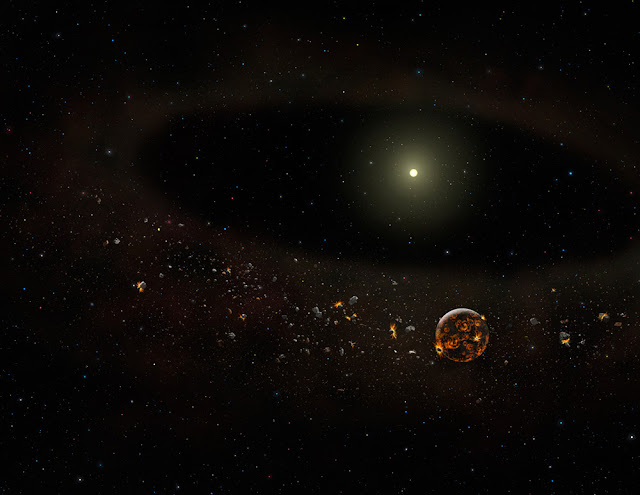At about 450 light years from Earth, towards the southern constellation of Centaurus, there is a solar-type star with a name similar to a taxpayer number: TYC 8241 2652 1. Since 1983, thanks to observations from NASA's IRAS infrared satellite, we knew that a warm disk of dust was orbiting around the ten million years old star: a kind of space coat, able to transform into infrared radiation, i.e. heat, the light received from the young star.
For over twenty-five years this dusty disk has been there in its place, like many other circumstellar disks discovered in recent decades around other stars: structures that astronomers interpret as the hallmark of forming planetary systems. Then suddenly, in January 2010, the NASA's WISE infrared space telescope no longer finds the disk around TYC 8241 2652 1. Disappeared! Soon after, several other telescopes confirmed the discovery, including most recently the Gemini Telescope located in Chile, that on May 1st 2012 shooted an infrared image of the star, which showed the continuing absence of the dusty disk, two and a half years after WISE observations.The phenomenon is nothing short of bizarre. What happened to a mass of dust that could fill the entire inner solar system? Even more disconcerting is the rapidity of the disappearance, fast even on a human scale, not to mention the astronomical. A study published in Nature on July 5 describes the discovery and proposes some hypotheses to explain it, but the truth is that astronomers are groping in the dark. It is as if the Cassini probe overnight began to send images of Saturn without rings (with the difference that the disk disappeared around TYC 8241 2652 1 was far larger than the rings of Saturn).
The first conjecture proposed by the authors is that the disk was vaporized by a giant flare of the star. To this end, it would have required an emission of x-rays with an energy between 100 and 1000 times the brightness of the sun. However this hypothesis is implausible, if one considers that the star has a brightness of about 0.7 times that of the sun. Namely it is too weak to issue such a sudden burst of energy. In addition, x-rays produced by a blast so powerful were nevertheless ineffective to vaporize dust grains larger than 0.3 microns. But the calculations show that the disk around TYC 8241 2652 1 could contain much larger grains, with diameters up to 100 µm / 1 mm. So you have to find another culprit.
A more plausible scenario is the "collisional avalanche". The idea is that a series of collisions between planetesimals orbiting around the star has produced a large amount of small dust grains, so light as to be pushed away by stellar radiation, becoming projectiles capable, through countless collisions, to chop the other grains dispersed in the dusty disk. Given the right initial conditions, this mechanism may have triggered an uncontrollable chain reaction that, within a few years, has swept away the dust from the immediate vicinity of the star. This would explain the drastic reduction in the infrared emission from the star recorded by our instruments.
A final conjecture is that of the "runaway accretion". The idea this time is that the disk around TYC 8241 2652 1 contained, mixed with dust, an amount of gas as large as between one and ten times the mass of dust. Such a quantity of gas could have acted on the powders as a sort of aerodynamic brake, able to precipitate quickly the entire structure on the star. However, such a mass of gas was not observed and therefore its possible presence is highly speculative. In the case of a star as young as TYC 8241 2652 1, this gas, if any, may be a residue of the protoplanetary disk from which the star itself was born. Another possibility is that the gas is the result of vaporization of protoplanetary bodies, destroyed as a consequence of some giant collision. But the reality is that we do not know. We do not know how that dusty disk has suddenly disappeared. No matter how hard scientists try to find regularities in physical phenomena, it always happens sooner or later something unforeseen and at least temporarily inexplicable, that invalidates established theories and makes a clean sweep of the dominant beliefs.
 |
| This artist's concept illustrates a dusty planet-forming disk, similar to the one that vanished around the star called TYC 8241 2652. Credit: NASA/JPL-Caltech |
Sources:
- Carl Melis et al., Rapid disappearance of a warm, dusty circumstellar disk, Nature 487, 74–76 (05 July 2012)
- Mid-infrared flux measurements of TYC 8241 2652 1, Nature 487, 74–76 (05 July 2012)
- Going Out Of Business: Planet-Forming Disk Turns Off Lights, Locks Doors ..., Gemini Observatory, July 2012
- Stuart Wolpert, Astronomers discover Houdini-like vanishing act in space, UCLA News Release, July 05, 2012
- The Mysterious Case of the Disappearing Dust, NASA/WISE, July 5, 2012

